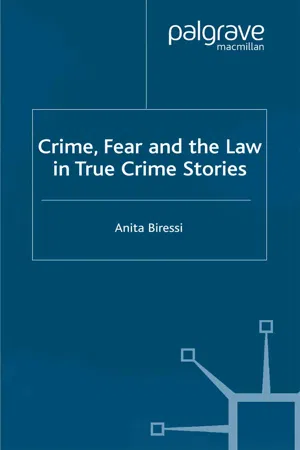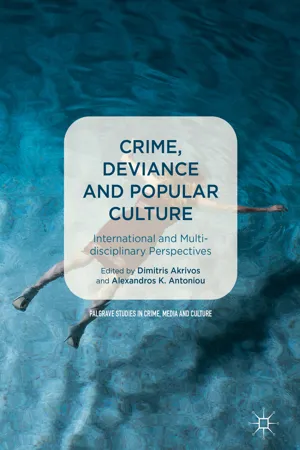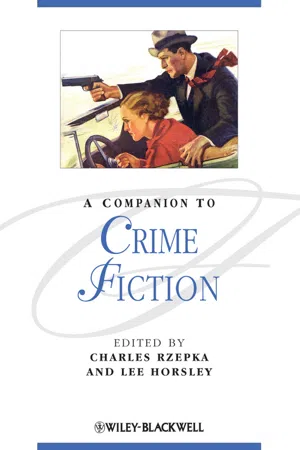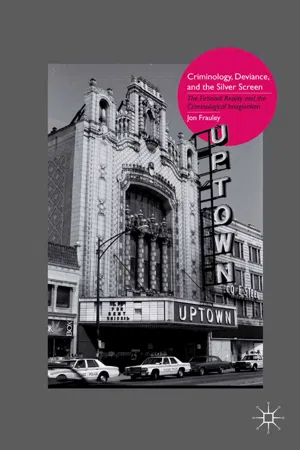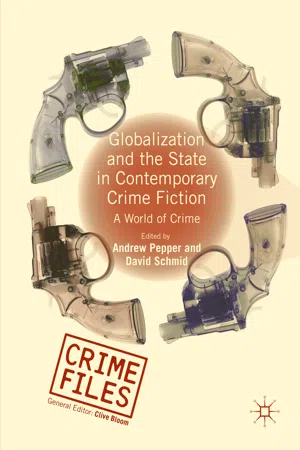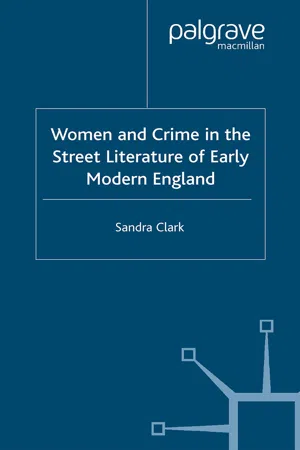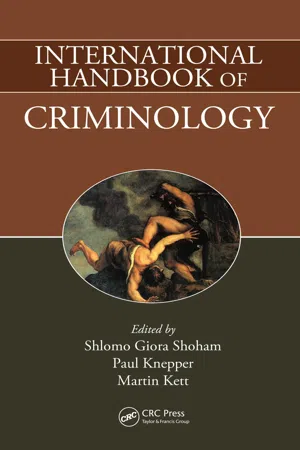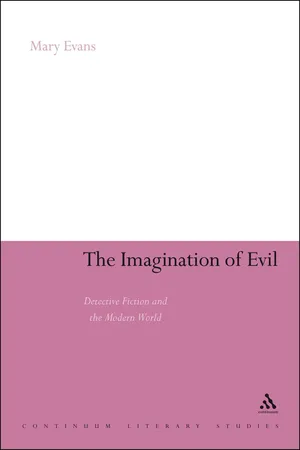Literature
True Crime
True crime literature is a genre that focuses on real-life criminal events, investigations, and legal proceedings. It often delves into the psychology of criminals and the impact of their actions on victims and society. True crime narratives are typically non-fictional accounts that aim to provide insight into the complexities of criminal behavior and the criminal justice system.
Written by Perlego with AI-assistance
Related key terms
1 of 5
10 Key excerpts on "True Crime"
- Anita Biressi(Author)
- 2001(Publication Date)
- Palgrave Macmillan(Publisher)
42 Crime, Fear and Law in True Crime Stories Having made the above caveats, the search for antecedents, when undertaken with caution, arguably augments an understanding of True Crime literatures, not simply as texts, but also as discursive formations which produce and disseminate knowledge about crime, punishment and other material conditions of everyday life at particular historical moments. Also, while one might turn to a recent True Crime text to learn how it orders, to a lesser or greater degree, knowledge of its his- torical moment, it is helpful to recall that it will also bear traces of earlier knowledges, practices and literary conventions, since there is no clear break between older and newer forms of popular literatures. Knowledge of these earlier conventions, and of how they have become sedimented into the genre, will therefore enhance analyses of current forms. Their traces, for example, will inflect present meanings and pleasures in different ways and this needs to be taken into account. Understanding change in True Crime literature It is arguable that the apparently consistent popularity of true accounts of crime, in all their variety (but especially of murder), lends itself well to speculation that the discourses of True Crime change little and its readership is relatively constant. The discourses of True Crime seem at first sight to develop and change incrementally along with the dis- courses that inform and construct our notions of crime, law and pun- ishment and with the broader transformations of Western society. These transformations from religious to secular society, from feudal- agrarian to industrial-capitalist society characterise Western modernity and may be read as largely progressive in nature, as part of a perma- nent revolution (Berman 1982).- eBook - PDF
The Rise of True Crime
20th-Century Murder and American Popular Culture
- Jean Murley(Author)
- 2008(Publication Date)
- Praeger(Publisher)
Building on the success 44 The Rise of True Crime of the magazines, True Crime as a literary formula found early expression in some 1950s texts, sprang seemingly sui generis from the pen of Truman Capote in 1965, and came into full flower during the 1970s and 1980s. Al- though murder narratives and nonfiction crime writing have a history that spans centuries, modern American true-crime writing began in the 1950s, as a new way of narrating and understanding murder—one more sensitive to context, more psychologically sophisticated, more willing to make forays into emotional identification with killers through novelistic techniques— emerged. Although formulaic and often devalued as pulp, true-crime literature does valuable cultural work, as it contains multiple and (often) contradictory messages about violence, gender, and fear in American life. True Crime has become a pop culture juggernaut in publishing and a cultural barometer that registers shifting fears about crime and violence in America. From its inception and formation as a distinct genre, true-crime literature has created a nonfiction American landscape of paranoia and danger, random violent crime and roaming serial killers, of mortal threats to women and children from sociopathic husbands, serial rapists, and preda- tory child-killers. Paradoxically, the genre also assuages such fears, because most true-crime narratives present cases that have been cleared or solved, thereby reordering the violently disrupted social world and reassuring read- ers that horrifying criminals do not escape punishment, although normal life is regularly and radically altered by acts of extreme violence. True-crime books remain intensely popular, although sales have fallen off somewhat since a high point in the late-1980s, perhaps a result of the prevalence of true-crime television programs and the easy availability of quality true-crime material on the Internet. - eBook - ePub
Crime, Deviance and Popular Culture
International and Multidisciplinary Perspectives
- Dimitris Akrivos, Alexandros K. Antoniou, Dimitris Akrivos, Alexandros K. Antoniou(Authors)
- 2019(Publication Date)
- Palgrave Macmillan(Publisher)
The structure of conventional True Crime texts is in four parts: murder, biographies of the victims and killer, pursuit of the killer, and punishment of the killer. Some form of justice, usually the incarceration or execution of the perpetrator, is achieved by the end of the story. This structure mimics that of classical detective fiction; social order is re-established by the apprehension and punishment of a killer, reassuring the reader that justice does prevail and that our legal system works. Many writers who tackle murder narratives have some connection to a particular case: they are often journalists, investigators, law enforcement agents, or lawyers who have covered the crime for a media source or pursued and prosecuted the offender. True Crime books in this tradition include Capote’s In Cold Blood (1966), all the work of Ann Rule, and other books too numerous to list; television in this mode can be found on many shows produced by the ID Network (Investigation Discovery), and the long-running (1996–2011) television program ‘Forensic Files’ is a prime example of this form. Less common are the narratives penned by victims and survivors of extreme violence. These stories operate in an entirely different emotional register, as they give intimate details not just of murder, but of intense suffering and the extremely complex and challenging aftermath of violence. A distinct sub-group within the larger genre, True Crime memoirs suggest different ways of understanding and making sense of violence and trauma that do not rely on the conventional gothic formula that presents a simplistic view about innocence and evil - eBook - PDF
- Charles J. Rzepka, Lee Horsley, Charles J. Rzepka, Lee Horsley(Authors)
- 2010(Publication Date)
- Wiley-Blackwell(Publisher)
The reader of True Crime takes great comfort in the deterministic logic that binds these children to their evil fate from their very earliest days. No matter how absurd this determinism may be, it has the advantage of making that apparently ordinary life as deviant as possible from its very beginning. I have described in this chapter the significant points of continuity and difference in the ways contemporary True Crime narratives and earlier examples of the genre manage the tensions involved in deciding whether criminals should be located inside the community or outside, whether they should be seen as representative subjects or monstrous outsiders. Although the emphasis is overwhelmingly on the need to cast the criminal out of the social, I have demonstrated that this move can never be per- formed cleanly or conclusively by any culture because of culture’s complex and ambivalent relationship with the figure of the criminal. 16 Gangs and Mobs Jonathan Munby Towards a History of Gangster Fiction The fact that a substantial amount of crime fiction features gangs and mobs has not encouraged academics, publishers or bookstores to adopt and deploy the term “gang- ster fiction” in any systematic way. I contend, however, that a host of different works covering a significant period of time share conventions and tropes sufficient to con- stitute a distinct tradition of gangster literature. Symptomatically, perhaps, it is under the “True Crime” category that gangster fiction’s closest relation is to be found (see Schmid, chapter 15 in this volume). Biographies of mobsters and “exposés” of crime syndicates by investigative journalists and undercover agents are only a small step from the fiction that is inspired by real underworld escapades. Like “True Crime”, gangster fiction explores an otherwise hidden parallel world. The genre label “gangster” crosses over from Hollywood. - eBook - PDF
Criminology, Deviance, and the Silver Screen
The Fictional Reality and the Criminological Imagination
- J. Frauley(Author)
- 2010(Publication Date)
- Palgrave Macmillan(Publisher)
Criminology and Its Relation to the Fictional Reality: Three Views There is a growing but fragmented body of literature within crimi- nology and criminal justice studies that takes fiction as its object of inquiry. On the one hand, there is an exploration of representations of popular attitudes toward crime or how criminological themes and issues are reflected in film and literature (Fiddler 2007; Gehrke 2001; O’Brien et al. 2005; Pearce 1978; Rafter 2006, 2007; Ruggiero 2002, 2003; Tzanelli, Yar, and O’Brien 2005). On the other hand, literature has been explored for how it might be used to exemplify sociological and criminological concepts—that is, the major ideas criminologists and sociologists work with to describe and explain what they are studying (Engel 2003; Hagan and Benekos 2002; Laz 1996; West 2005). Both bodies of literature, although not unified, are con- cerned with the fictional reality. Broadly, the first body of literature explores the intersection of criminology and popular culture to push the boundaries of criminological theory, research and, understanding. The second approach explores how criminological research, theory, and understanding can be represented to students and scholars alike. These studies have helped to legitimate investigation of fictional reali- ties as objects of criminological inquiry. The work by Jeff Ferrell and cultural criminologists has helped to explicitly identify popular culture, especially “everyday life,” as some- thing of criminological interest. Traditional criminological objects of study include crime, criminality, official crime control, victimiza- tion, and to a lesser extent, the political process of criminalization (the production of categories of crime). A fundamental argument of cultural criminology is that these criminological objects can be made much more intelligible if approached as cultural practices or practices that in some way seek to produce or reproduce culture. - eBook - ePub
Globalization and the State in Contemporary Crime Fiction
A World of Crime
- Andrew Pepper, David Schmid, Andrew Pepper, David Schmid(Authors)
- 2016(Publication Date)
- Palgrave Macmillan(Publisher)
True-crime is crime fact that reads like, or looks like, crime fiction…True-crime maps that vague and shifting region between real and fictional reality where mass belief resides. Thus, the known world of true-crime—the world as the scene of the crime—is bound up through and through with the reality of the mass media. (Seltzer, 11)Serious journalists and others who engage in true-crime investigation have traditionally derided the nota roja . It uses incendiary headlines and extraordinarily gruesome photographs, and puts little value on truth-seeking. Among crime tabloids Alarma! a.k.a. El Nuevo Alarma! and AlarmaRevista! has been particularly reviled as appealing only to the subliterate, as for instance, by Daniel Hallin:México tiene asimismo semanales sensacionalistas como ¡Alarma! , el cual ofrece un tipo de violencia obscena, como historias sobre atentados y, sobre todo, impactantes fotografías de cuerpos que han sido víctimas de accidentes o crímenes. La audiencia de estas publicaciones está constituida por varones de clase trabajadora, pese a que este grupo no es un fuerte consumidor de prensa escrita en México.[Mexico also has sensationalist weeklies like ¡Alarma! , which offers a kind of obscene violence, such as stories about assaults and, above all, shocking photographs of bodies that have been the victims of accidents or crimes. The readership of these publications is made up of men of the working class, in spite of the fact that this group is not a great consumer of the print news in Mexico]. (Hallin)On the other hand, serious journalists have not always acknowledged their own complicity in constructing the narrative of mayhem. Much of the reporting on “el narco” and “las muertas” is presented as an accumulation of empty linguistic commonplaces. Ignacio Corona terms this “an editorial politics of non-knowing,” in which “the news coverage spreads a discursive network over the ‘factual gap’ of the events” (106). Such reports parrot the official story with little investigative critique, and headlines syntactically imply agency and intention without specificity: “Matan a uno a golpes…Irrumpen en convivio y tirotean a pareja… Arrojan cadáver en la colonia Lino Vargas…Matan a menor de varias cuchilladas…Lo ejecutan en la colonia Del Carmen…A puñaladas matan adolescente…Siguen abusos,” and so on. The unnamed “ellos” of these constructions puts the focus on detailed descriptions of crime’s effects, rather than its agents. - eBook - PDF
Books and Beyond
The Greenwood Encyclopedia of New American Reading [4 volumes]
- Kenneth Womack(Author)
- 2008(Publication Date)
- Greenwood(Publisher)
com/clews/; Jenkins, Philip. Using Murder: The Social Construction of Serial Homicide. New York: A. de Gruyter, 1994; Knox, Sara L. Murder: A Tale of Modern American Life. Durham, NC: Duke University Press, 1998; Lane, Roger. Murder In America: A History. Columbus: Ohio State University Press, 1997; Lesser, Wendy. Pictures at an Execution: An Inquiry into the Subject of Murder. Cambridge: Harvard University Press, 1993; Ressler, Robert K., and Tom Schachtman. Whoever Fights Monsters. New York: St. Martin’s Press, 1992; Sanders, Ed. The Family. 1971. New York: Thunder’s Mouth Press, 2002; Seltzer, Mark. Serial Killers: Death and Life in America’s Wound Culture. New York: Routledge, 1998; Seltzer, Mark. True Crime: Observations on Violence and Modernity. New York: Routledge, 2006; Schmid, David. Natural Born Celebrities: Serial Killers in American Culture. Chicago: University of Chicago Press, 2005. JEAN MURLEY True Crime LITERATURE 1063 This page intentionally left blank U URBAN FICTION Definition. Urban fiction, potentially so broad a term as to encompass any work set in a city, requires specific definition. One approach is to work from critical cri- teria of what makes a work’s relationship to the city its definitive quality; another is empirical, observing that in the current publishing and retail markets, “urban” refers primarily to inner-city youth culture. Critical definitions of urban fiction are necessarily inconclusive, and overlap extensively with other genres. Detective and crime novels, novels of immigrant expe- rience, financial thrillers, and chick lit all remain popular fictional interpretations of city life. In an urbanized society few works, save perhaps those set in rural places, do not fall under the broadest definition of urban literature, and few works of urban literature cannot be placed in another genre. - S. Clark(Author)
- 2003(Publication Date)
- Palgrave Macmillan(Publisher)
114 The expression of such a view in popular crime reports affirms its function as ‘didactic and normative’. 115 It aims to promote social consensus, to slot invisibly into the framework of values and concepts that creates the preva- lent ideology. It is hardly necessary to mention that the events described in these texts (though not, of course, their meaning) would have had little direct bearing on the lives (as distinct from the belief systems) of those who read them; the nature and incidence of violent crime in reality was quite unlike its textual representation, 116 and however devout the public belief in 24 Women and Crime in the Street Literature of Early Modern England prodigies and monsters, few could ever have claimed an encounter with them. The texts manipulated images of a world that was horrifying, but ulti- mately also reassuring, and in this it was a model for the world of the readers’ experience. Crime pamphlets, like those for most categories of news in this period, reg- ularly advertise themselves with emotive title-page adjectives that draw atten- tion to the sensational aspects of the story – ‘wonderful’, ‘horrible’, ‘strange’, ‘barbarous’ – but just as often with ‘true’, for example, Bloody Newes from Dover. Being A True Relation of the great and bloudy Murder, committed by Mary Champion (an Anabaptist) who cut off her Childs head, The most wonderfull and true storie, of a certain witch, named Alyse Gooderige of Stapenhill, Newes from the Dead. Or, A True and Exact Narration of the Miraculous Deliverance of Anne Greene. Würzbach cites a number of ballads whose titles contain the word ‘true’, and mentions ‘true relation’ as a particularly prominent formula. She identifies the ‘speaker’s and the storyteller’s act of maintaining that he is speaking the truth’ as a ‘traditional topos’, a primary function of which is to personalise the ballad’s message.- eBook - PDF
- Shlomo Giora Shoham, Paul Knepper, Martin Kett(Authors)
- 2010(Publication Date)
- Routledge(Publisher)
16.2.2 Truth A constant feature of the crime genre (and of criminology) is the search for the truth. Much like traditional criminologists searching for objective facts about crime, crime genre protagonists search for the true facts of their cases—they want to identify the guilty parties who committed the crime. Often, the search for and importance of truth are specifically invoked in dialogue. Recently, as we watched a crime drama, we observed previews for other crime series. A recurring theme in the snippets of dialogue was that protagonists in the previewed programs claimed to be seeking the truth. One lead character said, “I’ve got to get to the truth.” Another protagonist said, “I see the truth.” Also, like traditional criminologists, detectives’ methods for discerning truth are varied both within and across programs. Some use such traditional investigatory methods as observation and deduction, and some blend these * For in-depth reading about reality television, we recommend four books: Entertaining Crime: Television Reality Programs , ed. Fishman and Cavender [1998]; Understanding Reality Television , ed. Holmes and Jermyn [2004]; Reality TV: Remaking Television Culture, ed. Murray and Ouellette [2004]; and Better Living through Reality TV , by Ouellette and Hay [2008]. Truth, Reality, Justice, and the Crime Genre 461 traditional methods with modern forensic techniques to discern the truth of the case. Most recently two other significant and paradoxical trends have gained widespread popularity in the crime genre: forensic and paranormal investigative programs. We argue that each of these types of investigative series provides interesting cultural insights and that even the more tradi-tional investigative series present nuances reflective of contemporary cul-tural concerns. We discuss each of these program types and provide program exemplars in the paragraphs ahead. - eBook - PDF
The Imagination of Evil
Detective Fiction and the Modern World
- Mary Evans(Author)
- 2009(Publication Date)
- Continuum(Publisher)
But together with these possible explanations, there is another possibility that reading fiction about crime is the most vivid account that we have of west-ern societies’ various fears and preoccupations. For this reason, this account does not follow the usual chronological account of authors but instead looks at the themes which have been central to crime and detective fiction and the way in which they articulate social concerns. For example, the detective and crime fiction of the nineteenth century is discussed in terms of northern Europe’s terror and vicarious delight in the city, a dual morbid-ity which informs the work of Edgar Allan Poe, Wilkie Collins and others. In the same vein, we can read recent writing by female authors about crime as indicative of the long-standing dialogue between women about both the possibilities of emancipation and fears about it. For example, Mary Astell, the English essayist of the late seventeenth century, wrote eloquently in favour of more independent lives for women. At the same time, her politics remained, in the context of the world in which she lived, deeply conserva-tive. We find this fault line throughout the subsequent centuries and no more vividly present than when women write about crime. The questions are not therefore about how much detective or crime fiction we read and watch, but why this genre of literature has such a hold on the public imagination and why we are so concerned with the detection of events (most often murder) outside general experience. One of the most Making Crime 13 salutary contributions of the academic study of crime in the past 30 years has been to demonstrate that most people living in the west will have little or no direct involvement in serious crime. Murders are seldom random; the idea and the fear of being attacked by a strange person are happily seldom realized.
Index pages curate the most relevant extracts from our library of academic textbooks. They’ve been created using an in-house natural language model (NLM), each adding context and meaning to key research topics.
